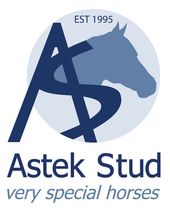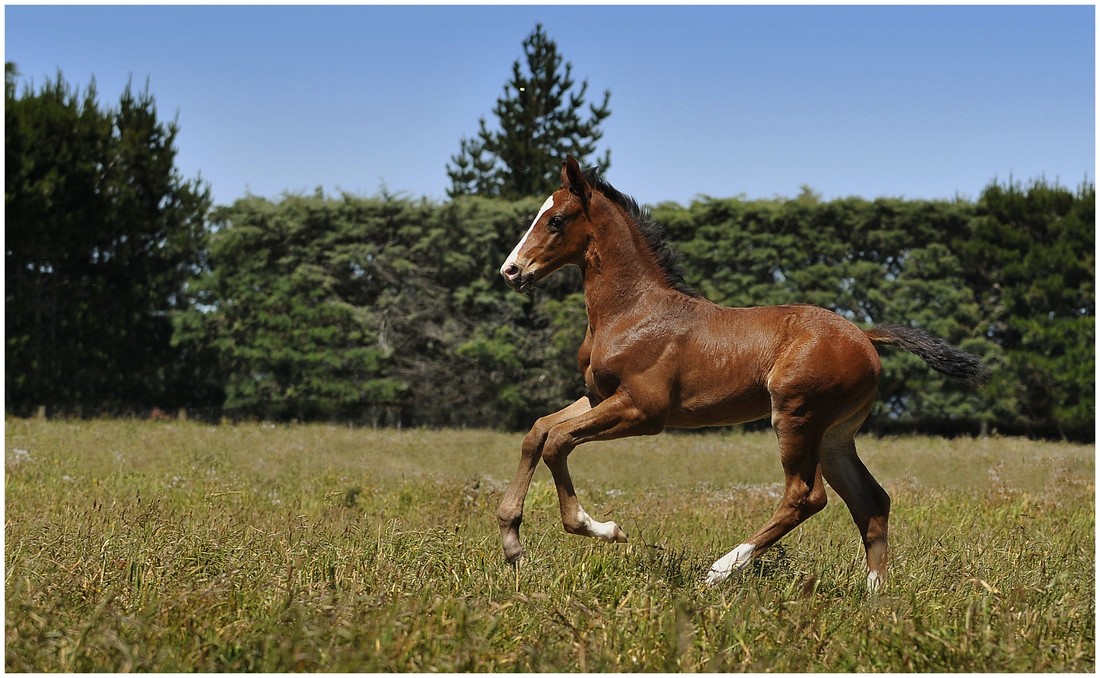|
A GENERAL OUTLINE OF WHAT IS INVOLVED Written by Astek Stud, Nelson, New Zealand When people come to us interested in breeding a foal, our first question to them is what sort of riding they are interested in and what type of horse they would like to produce? It makes sense to chose the best sire and mare you can, that are most likely to breed a foal suited to your own size, personal preferences and favourite disciplines! Sire choice will also be greatly influenced by your mare.
Choose a stallion that will complement your mares weaker points and enhance her good points. For example perhaps your mare needs a settled natured stallion to counteract her “fizzyness,” or you’d like a foal with more bone than your fine boned mare, she needs a better length of rein, you want to enhance her jumping style or movement etc. While the perfect horse is never born (we are all working on it!), considering these things will narrow down your options and make choosing a little easier, and of course, hopefully ensure the resulting foal is every bit worthwhile of your time and investment. Once you have decided on some suitable stallions, contact the stallion owners and talk to them about the horse or if possible go and meet them in person. This is a great chance to find out as much information as you can about the stallion, as well as checking out the stud facilities and the people ensuring it is a place you are comfortable about sending your mare to (if she isn’t going to be inseminated at home). It is a very wise idea to ensure the stud has a written Stallion Service Contract as this keeps the agreement clear so everybody knows where they stand. Once your stallion decision has been made, contact the stud again and book your mare in for service. This can be important as some stallions only serve a limited number of mares per season. Usually a booking fee is required at this stage – check to see whether it is included or is additional to the stated service fee. If your mare is staying at home for service you will need to have adequate facilities to scan and inseminate her. This requires some sort of crush for her to stand in, and may require power unless your vet has a battery operated scanner. (Some mare owners with quiet mares have improvised with a gate next to a shed or yard quite successfully.) Try to take note of when she is in season. Some mares ‘show’ if there is another horse, especially a gelding, nearby while others can be more difficult to tell. Your mare is likely to ‘show’ by lifting her tail, urinating frequently and showing interest in being close to other horses. If in doubt, you may need to have your vet come and scan the mare so they can estimate where she is at in her cycle. Mares are usually in season for about 5 days during which time the follicles on their ovaries increase in size to about 40 to 50 mm before they ovulate – insemination ideally needs to occur as close to ovulation as possible to achieve a pregnancy. We suggest scanning on about the 3rd or 4th day of her cycle, your vet will suggest best time for service. Check your Service Contract at this time as many studs require the remainder of the service fee to be paid BEFORE the first collection of semen takes place to inseminate your mare. This payment confirms your booking and often includes the first collection fee. Contact the stallion owners around this time too to keep them updated and let them know when you will need to serve your mare. Most studs appreciate at least 24 hours notice, but sometimes nature requires immediate action! The stud will collect and prepare the semen before transporting it to you. Your vet will need to be organised to inseminate your mare. The semen needs to be used as quickly as possible after collection. Most studs have an Insemination Certificate that travels with the semen and must to be completed by your vet and returned to the stud to verify details. Sometimes your mare may ‘hold on’ to the follicle for longer during her season, in which case your vet may advise she is served again. A sudden cold snap of weather for example can delay her ovulating. It is advisable that your mare always be scanned within 36 -48 hours of being served to ensure she has ovulated. Most fresh semen has a life of maximum 48 hours. If your mare is going to stud for service, you may send her when you first notice her coming into season. Of course, if she is currently in foal she wont be showing any season, you are wise to send her to stud at least 5 weeks before her due foaling date. She needs to be settled and relaxed in the new stud environment to have her foal and a long trip may be stressful in her final stages of pregnancy. Otherwise, if you are foaling her down at home, it is best to wait until you feel the new foal is old enough to travel, and send them to stud together. Tell the stud of her breeding history if known and any behavioural traits or special requirements she may have. At stud your mare will be scanned and inseminated at the studs’ discretion and they will keep you informed of her progress. Once she has gone out of season (and has been scanned for ovulation just to be sure), we suggest scanning again at 14 days post last date of service to check for pregnancy, also a vital time to check for twins. If your mare is in foal with a single pregnancy, great news! Your foal has been conceived and is beginning to form into your future superstar!! If twins are detected, it is best to follow your vets’ advice on what to do, they may try to “squeeze” one out, or prefer to leave them if they are very close together and cannot be pushed apart then checked again in 48 hours to try again to separate them. The survival rate of healthy twins in horses is very low as the uterine wall cannot easily support the growth of two placentas, so this is a time when having an experienced equine vet is extremely valuable. If your mare isn’t in foal, it can be disappointing however she will be due to cycle again and you can try again. Most mares that are reasonably young, in good health and their services are well timed generally conceive on their first or second cycle. Mares that have had past problems breeding/foaling, are older or in poor condition, or have a lot of fluid or cysts in their uterus may take more time and be harder to get pregnant. Good timing and veterinary advice is essential. Assuming your mare has had a positive 15 day pregnancy test and everything looks fine, you then need to wait until around 28 days post service and scan her again, at this time the foal’s heartbeat is detected and this scan is to ensure the pregnancy has been maintained, is growing and looks healthy. Following this, a final 42 day scan will ensure the pregnancy is developing as it should. Once the 42 day scan has been completed, contact the stud and they will issue you with relevant Certificates of Service after all due invoices have been cleared. This Certificate is proof of your service and is needed for future foal registrations and for rights of return should your mare happen to lose the foal at some stage. If your mare is at stud, she is now ready to come home. Some local mare owners prefer to take their mare home after service and bring her back to stud for the 15 and 42 day scans, some take their mares home after the 15 day scan and perhaps get their own vet to perform the subsequent scans. Some studs only operate a “walk in walk out” service where your mare comes to stud for the duration of her season, is served accordingly, and sent home again. Other studs do not take any outside mares onto their property and, if you haven’t got your own facilities, you may need to send the mare to your local vet or another stud where she can be served and scanned. The main consideration here is for your mare, as you want her as settled and relaxed as possible to achieve a pregnancy. If your mare has been at stud, there will most likely be agistment costs that are payable monthly or when your mare leaves. Foaling fees are also common if she had a foal while at stud. Some studs charge a handling fee for every time your mare is brought in for service or scanning. As said earlier, these are all part of the service contract so make sure it is clear and you have read it well. Now, all that is left to do is look after your mare well through the winter and wait until approx. 11 months are up for your new foal to arrive! Most studs are very interested to hear about your foal by their stallion so keep in contact with them and let them know the outcome. If something does happen to go wrong during your mares pregnancy or at foaling and she loses the foal, here is where your service contract comes into play again, as most studs offer a Live Foal Guarantee (LFG) and Free Return meaning you can have another stallion service to your mare without repaying the entire service fee. OUTLINED COSTS OF BREEDING SPORTHORSES
Please note: The above outline has been written as an estimated guide only for breeding costs in New Zealand using fresh/chilled semen. Frozen Semen services require a very accurate scanning routine as insemination of frozen semen ideally needs to occur within just 3 to 5 hours of ovulation, (compared to fresh or chilled semen which is viable for much longer) This can mean scanning your mare every few hours and therefore increases costs considerably. A point to remember! Comments are closed.
|
AuthorSue Fowler Archives
July 2021
Categories |
Astek Stud will help you choose your next "Very Special Horse"
|
Katie Bird - Sophie Wilkinson
VISIT Poihipi Road, Taupo CONTACT [email protected] Follow us on FACEBOOK and INSTAGRAM |


 RSS Feed
RSS Feed